-
Viewpoint on 'IONS'
Viewpoint on 'Scientific Literacy'
- Proudly sponsored by
-


-
Subnanometer Perfection
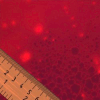
According to French philosopher Voltaire (1694-1778) the perfect is the enemy of the good, thus not exactly desirable. As recent results show, however, where scientific research is concerned this may not always hold true.
-
The Five Dimensions of Optical Storage
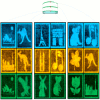
Can 300 DVDs be squeezed into a single optical disc? Ground breaking research in the field of surface plasmon physics seems to suggest so.
-
The Random Walk towards Quantum Computing
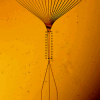
Subtle quantum effects will be at the heart of the quantum computers of the future. Very few existing setups, however, offer the necessary stability and control to exploit such effects at the moment. Arrays of waveguides meet this challenge.
Volume 17 Story 5 - 26/7/2012

For most people, looking at a fresco on the vault of a cathedral inspires a sense of spirituality. For a curator, it raises more earthly questions: What pigments did the artist use? Has the painting undergone restoration? What is there behind the outer layer of color? Answering these questions without taking the painting apart, is a real challenge. Light comes to the rescue and permits scientists to explore the precious artwork without so much as touching it. Italian researches Claudia Daffara at the University of Verona, Dario Ambrosini and Domenica Paoletti at the University of L’Aquila, and Luca Pezzati at the Istituto Nazionale di Ottica in Florence have now developed a technique that makes use of mid-infrared radiation to extract hidden information from a painting.
Preserving works of art is important. Professionals in charge of preserving and restoring them to their original glory are faced with the dilemma of doing so in the least intrusive way possible, without destroying them. This task faces conflicting requirements. On the one hand, one needs to intimately know every detail of the painting: when and how it was painted, whether it has undergone any restoration, and so on. On the other hand, one should spare no effort to avoid any damage to the painting, and this rules out most standard laboratory techniques, one of which involves removing and analyzing a sample of the artwork. Imagine, for example, the outrage the suggestion of removing the external layer from La Gioconda would cause, even if the reason were to have a look at Da Vinci’s preparatory drawings underneath. Would you not love to be able to just do that, though!
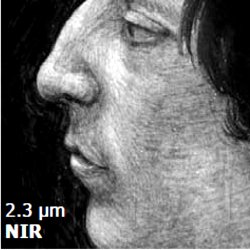
Optical techniques come to the rescue. Light, indeed, can deliver a wealth of information about a painting without any physical contact. The simplest techniques based on interferometry and holographic imaging, which can accurately measure the surface of an object, have been able to assess in great detail the outer layer of a painting using normal visible light, identifying, for example, structural defects such as cracks. Using more advanced techniques, such as for example Raman spectroscopy, which can extract a fingerprint of the chemical composition of an object from the light the object scatters, it has been possible to go further and to study even the chemical composition of the colors used in a painting. "Optical techniques are now fundamental in the artwork field for documentation, treatments (e.g. laser cleaning) and most of all, diagnostics," Daffara explains. "They can be used to see details that cannot be revealed with the naked eye but also to detect structural defects, often at a very early stage."
Thermal Quasi-Reflectometry, the technique developed by Daffara and colleagues, illuminates the painting under study with a small amount of mid-infrared radiation, a form of light we cannot see with the unaided eye, and it records with a standard infrared camera, or thermal camera, the light that gets reflected. In this way, it is possible to discern various details of the painting that are not detectable with visible light. For example, it is possible to recognize different materials used in a painting, distinguishing in this way between the original artist’s work and later restorations. "The first advantage of our technique, we believe, is its extreme simplicity and portability," Daffara concludes, "one only needs a thermal camera in the mid-infrared, and a proper illumination, that can also be achieved in a very simple way. Secondly, the system shows a very good capability of differentiating the materials of a surface."
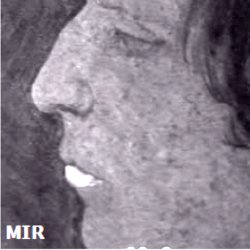
"Usually the optical techniques are an outstanding method for diagnosing the paint layers,”" agrees Cecilia Frosinini from the Wall Painting Conservation Department at the Opificio delle Pietre Dure in Florence, Italy, "but they can provide less information in terms of knowledge of the multilayered composition of a complex structure. This is the first time we have been able to get in depth knowledge using an optical technique."
So where do we go from here? The next step would involve making the technique more accessible to restoration and conservation specialists, in a way that is "effective but easy to use by non-optically skilled people," as Daffara points out, thus creating "a better connection between restorers and the optical community." Just like any other new approach, once wider appreciation is gained through its becoming widely used by restorers in museums and restoration labs, then a real difference can be made.

The Artistic Touch of Light
Art masterpieces reveal surprising facets when we look at them through different eyes. Visible light is not always enough to disclose all of the details they hide. Use thermal radiation, however, and a good deal of their mysteries can be unveiled.
Visible image. A standard picture of a fresco painting shows the features we can see with the unaided naked eye. Detail of a fresco model, copied from Ghirlandaio, taken around 1930 by the restorer Benini.
Preserving works of art is important. Professionals in charge of preserving and restoring them to their original glory are faced with the dilemma of doing so in the least intrusive way possible, without destroying them. This task faces conflicting requirements. On the one hand, one needs to intimately know every detail of the painting: when and how it was painted, whether it has undergone any restoration, and so on. On the other hand, one should spare no effort to avoid any damage to the painting, and this rules out most standard laboratory techniques, one of which involves removing and analyzing a sample of the artwork. Imagine, for example, the outrage the suggestion of removing the external layer from La Gioconda would cause, even if the reason were to have a look at Da Vinci’s preparatory drawings underneath. Would you not love to be able to just do that, though!

Near-infrared image. A near-infrared image gets information from underneath the painting. Therefore, near-infrared imaging has been extremely useful in revealing features such as preparatory drawings that may lay there.
Thermal Quasi-Reflectometry, the technique developed by Daffara and colleagues, illuminates the painting under study with a small amount of mid-infrared radiation, a form of light we cannot see with the unaided eye, and it records with a standard infrared camera, or thermal camera, the light that gets reflected. In this way, it is possible to discern various details of the painting that are not detectable with visible light. For example, it is possible to recognize different materials used in a painting, distinguishing in this way between the original artist’s work and later restorations. "The first advantage of our technique, we believe, is its extreme simplicity and portability," Daffara concludes, "one only needs a thermal camera in the mid-infrared, and a proper illumination, that can also be achieved in a very simple way. Secondly, the system shows a very good capability of differentiating the materials of a surface."

Mid-infrared image. A mid-infrared image detects the material response of the more superficial fresco layer.
So where do we go from here? The next step would involve making the technique more accessible to restoration and conservation specialists, in a way that is "effective but easy to use by non-optically skilled people," as Daffara points out, thus creating "a better connection between restorers and the optical community." Just like any other new approach, once wider appreciation is gained through its becoming widely used by restorers in museums and restoration labs, then a real difference can be made.
Giovanni Volpe
2012 © Optics & Photonics Focus
GV is Assistant Professor at Bilkent University in Ankara (Turkey); his research focuses on optics, statistical physics and soft matter (http://softmatter.bilkent.edu.tr/).

Claudia Daffara, Dario Ambrosini, Luca Pezzati & Domenica Paoletti, Thermal quasi-reflectography: a new imaging tool in art conservation, Optics Express (2012) 20, 14746-14753 (link).